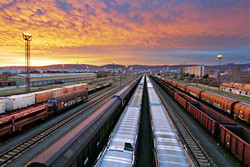New axle monitoring tools a boost for the rail freight sector
The three-year MAXBE project, which was completed in October 2015, sought to reduce the economic impact of axle bearing damage on rail operators by introducing new technology to achieve optimisationed, ongoing monitoring and maintenance. This will help to reduce the need for expensive inspections but at the same time improve safety, making rail freight transportation more economically attractive. This in turn will help take lorries off the road and have a positive impact on Europe’s environment. The axle bearing monitoring system developed by the project consortium can adopted by any type of rail network, which increases the potential exploitation of the technology. It is expected that the system will be of direct interest to operators and infrastructure companies, not only in Europe but worldwide. Furthermore, industrial companies involved in the project have gained a competitive advantage through following the technological progress of the research. This could lead to further innovations to make European rail even more competitive. In turn, participating universities and research institutes have enhanced their ability to train Europe’s next generation of railway engineers in cutting edge technology. The MAXBE project taps into rising European and indeed global demand for safe, environmentally friendly transport. In order to tackle these challenges, the railway sector must assume a larger share of transport demand over the coming decades. For its part, the European Commission is working to create a single European railway area in order to achieve a more competitive and resource efficient European transport system. However, despite public support for significant investment in infrastructure and high-grade technology, the share of overall transport use via rail remains relatively low – 6 % for passenger transport and 10 % for freight. Furthermore, a key challenge to achieving a truly integrated European rail network has been the fact that there has been a consistent lack of standardisation in this field. For example, there is no unified EU-wide documentation on guidelines for maintaining rolling stock with regards to axle bearings. The MAXBE project has addressed this by putting forward guidelines and protocols for implementing – across Europe – diagnostic systems for axle bearing conditioning. The long term objective of the project has been to enable Europe’s rail network to play a wider role in the global transport market, both by addressing urgent short-term technical issues such as maintenance and inspection, and by building upon a long term vision on how to offer an attractive alternative to other forms of transport. The MAXBE consortium brought together 17 partners from industry and academia. The team included rail operators, axle bearing manufactures and experts in the field of monitoring, maintenance and rolling stock. Manufacturers were supported by academics from various disciplines including, metallurgy, materials science, mechanical, civil, electrical, electronic and IT engineering. This breadth of expertise was crucial, not only for the project’s ability to enhance and optimise axle bearing diagnosis and maintenance, but to ensure that the tools developed have real market potential. For further information please visit: www.maxbeproject.eu (MAXBE project website)
Countries
Portugal



